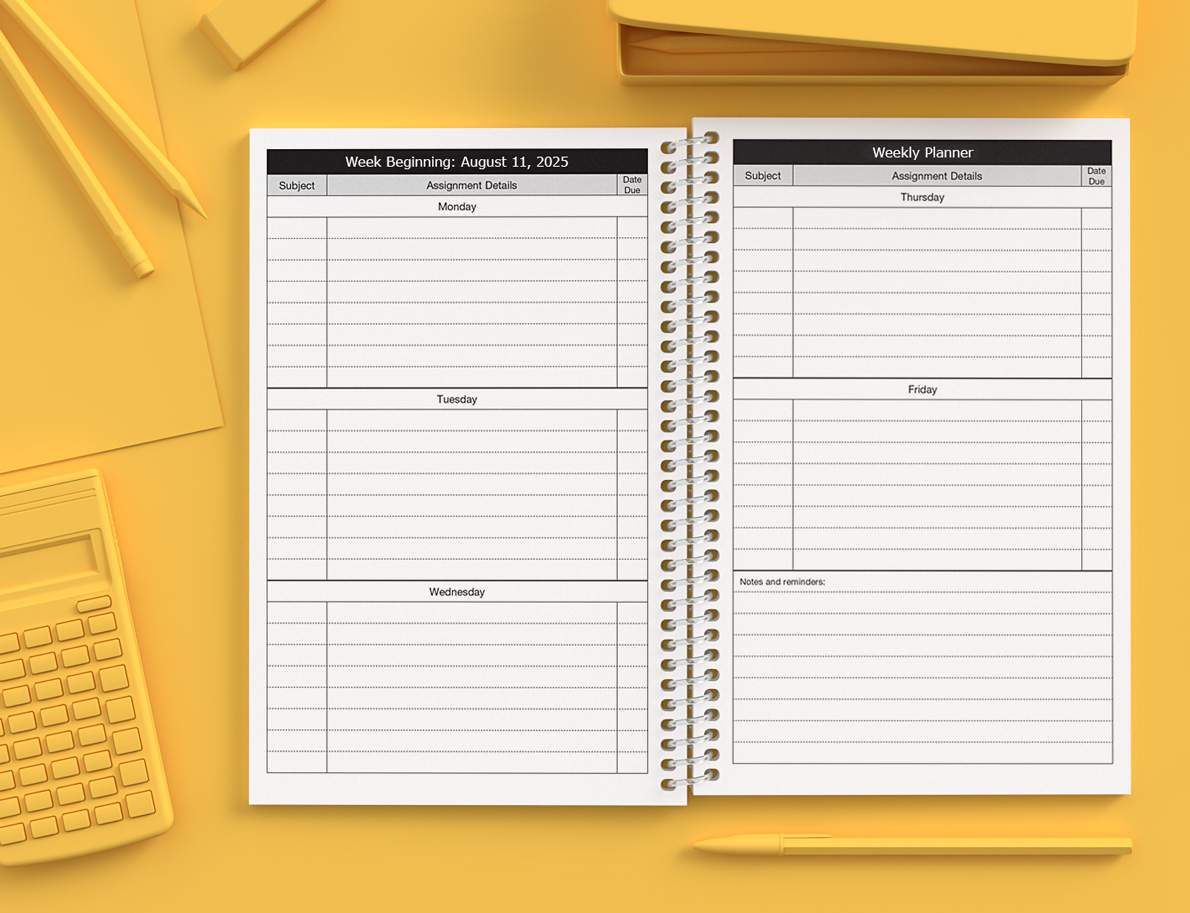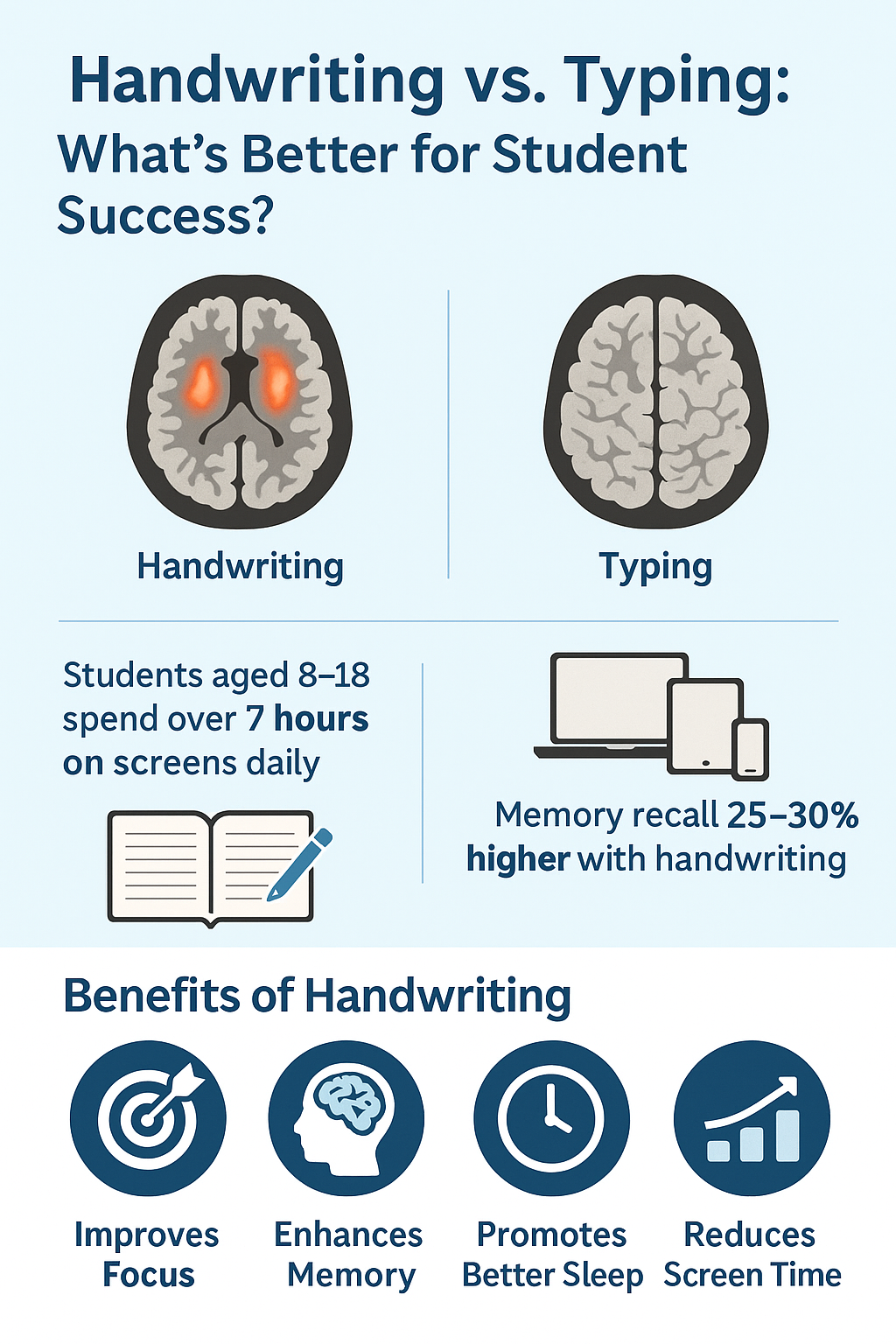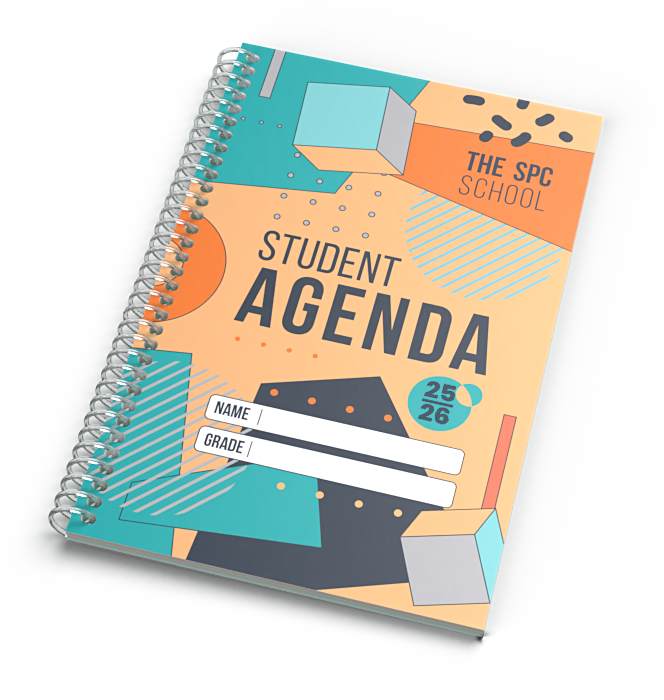The bad news: technology is here to stay. The good news: research shows handwriting tasks reduces screen fatigue and other symptoms of digital overwhelm. This is great news for educators looking for a solution to distracted students who seem increasingly more unable to focus, concentrate, or retain information.
In an age where digital devices dominate both learning and leisure, students are spending more time on screens than ever before. While technology has transformed education in positive ways, the side effects of prolonged screen use like eye strain, reduced attention spans, and difficulty retaining information are raising concerns among educators and parents alike.
One proven solution that’s making a comeback? Handwriting, especially in the form of daily and weekly planning.
Handwriting tasks reduces screen fatigue and encourages students to physically write down their goals, assignments, and to-do lists in a school planner. This is a benefit to both students and their families, as studies show writing down tasks can help students and adults alike achieve their goals. Below, we explore the powerful benefits of handwriting tasks, how it impacts student success, and why a well-designed school planner is more relevant than ever.

Why Handwriting Helps with Focus and Learning
Writing by hand stimulates more areas of the brain than typing. According to research published in Frontiers in Psychology, students who handwrite their notes show improved comprehension, critical thinking, and memory recall. When students write something down, they’re actively processing the information, which leads to deeper learning.
Does handwriting tasks reduce screen fatigue from screen time?
Yes. Writing tasks by hand helps students better focus, retain information, and break free from constant digital distractions, leading to reduced screen fatigue and better academic outcomes.
What’s the problem with too much screen time?
According to the American Academy of Pediatrics, students aged 8 to 18 spend over 7 hours a day on screens. While not all screen time is bad, extended use can lead to:
- Digital eye strain
- Sleep disruption
- Decreased attention span
- Mental fatigue and stress
- Reduced handwriting and fine motor skills
By integrating non-digital tools—like custom school planners—into the academic routine, schools can offer a simple, effective counterbalance.

The Benefits of Handwriting Tasks in a Planner
| Benefit | How It Helps Students |
|---|---|
| Boosts Focus | Writing helps cut through distractions and encourages single-tasking |
| Improves Memory | The act of writing reinforces learning and enhances recall |
| Reduces Screen Time | A physical planner means fewer digital reminders and less screen time |
| Encourages Goal Setting | Students can visualize and track academic and personal growth |
| Strengthens Executive Function | Planning and prioritizing tasks builds time management skills |
What Makes a Good School Planner?
Not all planners are created equal. The most effective ones are designed for students, by educators and include:
- Dedicated goal-setting pages
- Daily, weekly, and monthly views
- Space for reflection and habit tracking
- Homework and assignment logs
- Custom content relevant to the school or age group
We fully customizable planners for elementary, middle, and high school students—with layouts that foster better learning habits and reduce screen reliance.
Grade-by-Grade Benefits of Planner Use
| Grade Level | Key Skills Developed |
|---|---|
| K–2 | Routine building, picture associations |
| 3–5 | Time awareness, early goal setting |
| 6–8 | Independent planning, executive function |
| 9–12 | Goal tracking, stress management |
How Planners Help Build Long-Term Habits
When students are encouraged to use a physical planner daily, it helps cultivate good habits. Handwriting tasks reduces screen fatigue and also helps develop habits that last beyond the classroom, including:
- Personal accountability
- Time management
- Self-reflection
- Stress reduction through clearer planning and prioritization
This habit-building starts early—many schools use custom primary-level planners with picture symbols or visual routines, and build up to more advanced layouts in middle and high school.
Digital vs. Analog: Which is Really Best for Students
| Feature | Digital Tools (Apps/Calendars) | Physical School Planners |
|---|---|---|
| Requires screen time | ✅ Yes | ❌ No |
| Brain engagement (motor + visual) | ❌ Minimal | ✅ High |
| Distraction-free | ❌ No (alerts, messages) | ✅ Yes |
| Custom school branding | ❌ No | ✅ Yes |
| Age-appropriate content | ❌ Generic | ✅ Customized by grade/school |
💬 Educator Tip:
“We’ve seen a noticeable improvement in our students’ ability to concentrate and manage their time since introducing school planners. They’re more organized and less dependent on phones for reminders.”
— Middle School Teacher, New Jersey
How does handwriting improve student learning?
Handwriting activates multiple parts of the brain and encourages active processing, which boosts memory and focus—especially for younger learners.
Handwriting plays a powerful role in reinforcing learning by engaging multiple areas of the brain at once, including those responsible for language, memory, and motor skills. When students write by hand, they process information more deeply, leading to better understanding and retention. This active engagement helps improve focus, especially in younger learners whose cognitive and fine motor skills are still developing. Unlike typing, which can be passive and repetitive, handwriting encourages students to slow down, think critically, and form stronger mental connections with what they’re learning.
Are school planners still useful in a digital world?
Absolutely. School planners provide a tangible, distraction-free space for organizing assignments and setting goals. They complement digital tools without replacing them.
While digital tools are convenient and often necessary, school planners offer a unique, distraction-free environment where students can plan, reflect, and stay organized without the pings and pop-ups of screens. Writing things down helps reinforce goals and deadlines, making them more concrete and memorable. Planners also give students a sense of ownership and control over their schedules. Rather than competing with technology, planners complement it—providing a reliable backup, a visual planning space, and a chance to step away from devices during the school day.
Can planners really reduce screen time?
Yes. Using a physical planner for tasks, homework, and goals helps students cut down on unnecessary device use and gives their eyes a break from screens.
One of the simplest ways to reduce screen time is to replace digital task tracking and goal setting with a physical planner. Instead of toggling between apps or notifications, students can turn to a single, calming space to manage their responsibilities. This not only limits unnecessary device use but also encourages intentional time management. For students already dealing with screen fatigue or attention issues, using a paper planner can make a noticeable difference in focus, mood, and even sleep patterns.
What types of students benefit most from handwriting their goals?
All students benefit, but especially those who struggle with attention, executive function, or screen-related anxiety. Younger students and those in special education programs also benefit from the tactile and structured nature of planners.
While all students gain from writing their goals by hand, those with attention challenges, executive function difficulties, or screen-related stress often experience the greatest improvements. Handwriting goals engages their brains more fully and makes abstract ideas—like “stay organized” or “finish assignments on time”—feel more tangible and achievable. Students in special education programs often benefit from the routine, tactile structure that planners provide, while younger learners develop critical planning and motor skills through regular use. Handwritten goals can also support emotional growth by encouraging reflection, confidence, and accountability.

Final Thoughts: Give Students the Power of Pen and Paper
As schools look for ways to improve student well-being and performance, it’s clear that simple tools like custom school planners can make a big difference. By bringing handwriting back into daily routines, educators can equip students with better focus, stronger organizational habits, and healthier screen habits.
Looking to create custom school planners for your students? Let us help you build a solution that fits your school’s unique needs. Get a quote today.